E-Travel Log #6: A Chinese Food Overview
Attention Teachers: Please see teacher notes below.
Dear Students:
Fan chi le ma? Have you eaten? In this travel log, we’ll stop for lunch as we pass through two more old Silk Road cities. On the way, we’ll keep a look out for dragons; tell you more about gushi (ancient Chinese poetry); challenge you with two more guess-who poems about Asian animals; and list some more answers to your questions. Enjoy!
THE END OF THE SILK ROAD
So, saddle up your
steed! We’re heading back across the Gobi Desert, along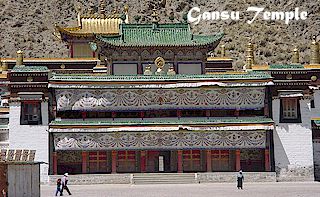 the old Silk Road, to Lanzhou, the capital of Gansu Province. From there,
we’ll veer south to the city of Linxia, where we’ll trade our
camels in for yaks (next travel log). If we were traveling this route over
600 years ago, we’d run into many a silk-hauling camel-drawn caravan
along the way. But now there’s just a modern road with an occasional
car or truck. Even less frequently, we see a train pass by or an airplane
fly overhead. We have lots of time to ponder, ‘What ever happened to
that old Silk Road, anyway?’
the old Silk Road, to Lanzhou, the capital of Gansu Province. From there,
we’ll veer south to the city of Linxia, where we’ll trade our
camels in for yaks (next travel log). If we were traveling this route over
600 years ago, we’d run into many a silk-hauling camel-drawn caravan
along the way. But now there’s just a modern road with an occasional
car or truck. Even less frequently, we see a train pass by or an airplane
fly overhead. We have lots of time to ponder, ‘What ever happened to
that old Silk Road, anyway?’
Well, do any of you own an LP record player (have you even heard of one?) or a typewriter? You see, the Silk Road sort of went out of fashion because technology improved and made it relatively useless. While warfare in the late 1300’s A.D. made Silk Road travel unsafe, people began using ships for global trade. It was much faster and much cheaper. By the time the Silk Road was safe again, maritime trade made it obsolete and it disappeared like a caravan in the Taklimakan.
MADE IN CHINA
Nowadays, we mostly use boats, trucks, trains and airplanes for international trade. And, of course, China exports much more than just silk, as you’ve probably noticed if you check the tags and labels of the things you buy.
WHAT DO YOU FEEL LIKE, CHINESE, ITALIAN OR ETHIOPIAN?
Do you like Chinese
food? Thought so! How about Italian or Mexican? Have you tried Greek or Ethiopian?
Indian or Thai? When countries trade and interac t
with each other, they also share their cultures. That’s easy to see
as we pass through Lanzhou and Linxia. The most beautiful buildings in town
are Islamic mosques and Buddhist temples. Islamic men, with their white caps,
and Islamic women, with their black headscarves, are as easy to spot as the
Buddhist monks in their flowing scarlet robes. We already told you how several
religions entered China via the Silk Road; well lots of food crossed the borders,
too. Some say Marco Polo introduced spaghetti to Italy after traveling the
Silk Road (while others insist he introduced noodles to China). Lanzhou, our
first stop for the day, not coincidentally, is considered the noodle capital
of China. So, let’s stop for lunch!
t
with each other, they also share their cultures. That’s easy to see
as we pass through Lanzhou and Linxia. The most beautiful buildings in town
are Islamic mosques and Buddhist temples. Islamic men, with their white caps,
and Islamic women, with their black headscarves, are as easy to spot as the
Buddhist monks in their flowing scarlet robes. We already told you how several
religions entered China via the Silk Road; well lots of food crossed the borders,
too. Some say Marco Polo introduced spaghetti to Italy after traveling the
Silk Road (while others insist he introduced noodles to China). Lanzhou, our
first stop for the day, not coincidentally, is considered the noodle capital
of China. So, let’s stop for lunch!
GREETINGS! HAVE YOU EATEN?
The phrase we started this report with, Fan chi le ma?, and another like it, Chi guo le ma?, both mean, ‘Have you eaten?’ In many parts of China, like Lanzhou and Linxia, these phrases are used as a greeting, sort of like, ‘How are you?’ The idea is: if you have eaten, you’re fine. To say you’re ‘fine,’ whether you’ve actually eaten or not, you can just say, Chi guo le, which literally means, ‘I’ve eaten.’ Or, if you are hungry, you can always try, Mei chi guo, and you might even be offered something to eat!
 GET WITH THE SLURP
GET WITH THE SLURP
Now, if you decide
to have noodles in this town famous for them, you’ve got to get with
the slurp! Slurping your noodles, far from being rude, is pretty near an 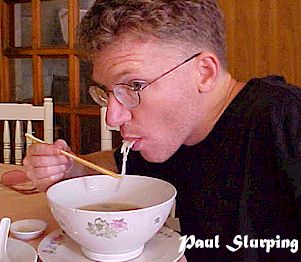 art
form in China. Since hot chili peppers are also an ingredient in Lanzhou beef
noodles, after a few slurps, you’ll also be sniffling. A meal of noodles
in a Lanzhou noodle restaurant is a virtual symphony of slurping and sniffling.
Go ahead, join right in: Slurp-slurp-slurp-slurp-slurp; sniff-sniff, sniff-sniff.
art
form in China. Since hot chili peppers are also an ingredient in Lanzhou beef
noodles, after a few slurps, you’ll also be sniffling. A meal of noodles
in a Lanzhou noodle restaurant is a virtual symphony of slurping and sniffling.
Go ahead, join right in: Slurp-slurp-slurp-slurp-slurp; sniff-sniff, sniff-sniff.
Slurping actually has a practical aspect to it, too. Most noodle connoisseurs like their Lanzhou beef noodles steaming hot. If you slurp, it helps to cool the noodles just enough before they hit your taste buds. Slurping, if you do it correctly, also prevents the hot soup that the noodles are served in from splashing onto your face, which will definitely happen if you suck the noodles up like you might spaghetti! So, now that you’ve got your slurping etiquette down, let’s move on to Linxia and try some other dishes.
HOT POT – A NORTHERN SPECIALTY
In Linxia, people
sell lots of Muslim specialties right out on the street, things that are hard
to find in other cities, like bing, nan and other breads, lamb shish-kabobs
and giant samosas. But, we’re going to have another specialty that originated
in northern China – hot pot. Hot pot is now served all over China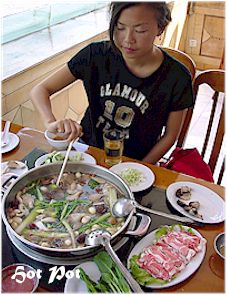 and originally was eaten in winter to keep people warm. To eat hot pot, you
first need a big hole in the middle of your table. Under the hole is a heating
device. A giant bowl of soup with a mix of flavorings, herbs and spices is
placed over the heating device so it continues to boil. You add your choice
of thinly sliced raw lamb and beef, seafood and a variety of vegetables and
dumplings to the bubbling brew, and then fish it out with chopsticks or a
spoon once it has cooked. Yum!!!
and originally was eaten in winter to keep people warm. To eat hot pot, you
first need a big hole in the middle of your table. Under the hole is a heating
device. A giant bowl of soup with a mix of flavorings, herbs and spices is
placed over the heating device so it continues to boil. You add your choice
of thinly sliced raw lamb and beef, seafood and a variety of vegetables and
dumplings to the bubbling brew, and then fish it out with chopsticks or a
spoon once it has cooked. Yum!!!
A FEAST FROM THE EAST
In China, people eat almost anything imaginably edible. Of course, they combine those many ingredients to make an incredible array of delicious dishes. We’ll sprinkle photos of just a small sampling from around China in the rest of this report – to whet your appetite. And just for fun, here’s a top-ten list of interesting things we have eaten during our travels in China. Which would you give a try?
10. Dragon
fruit – A mildly sweet fruit that resembles a red
dragon on the outside and has hundreds of small black edible seeds suspended
in juicy white flesh on the inside.
9. Chicken feet – A standard snack with beer.
8. Donkey meat – Another northern specialty.
7. Silk worms – Not only used for making silk!
6. Scorpions on a stick – Crunchy, tasty and considered
to have medicinal value (the poison i s removed!).
s removed!).
5. Yak dairy products – Cheese, butter, milk, cream;
there’s even a special tea made with yak ghee – and you can have
it with a yak steak if you like.
4. Duck tongues – They look funny and are a little
slimy, but they taste great.
3. Bamboo grubs – Fried in oil; crunchy on the outside,
oily on the inside and oh so yummy; just one of a variety of edible larva
and insect products available in Yunnan Province, including dragonflies and
grasshoppers.
2. Snake skin – The meat is good, but the gelatinous
skin is considered a delicacy.
1. Dog meat – Considered an excellent winter food in
northern China.
DRAGON FRUIT
Of the items on the list, dragon fruit might be the easiest to swallow for people who aren’t used to all the exotic items on the Chinese menu. Do you think they look like a dragon? In Chinese, they are actually called ‘Dragon Tongue Fruits.’
CHINA: THE DRAGON OF THE EAST
Dragons, which represent
magical and majestic power, are the symbol of China – 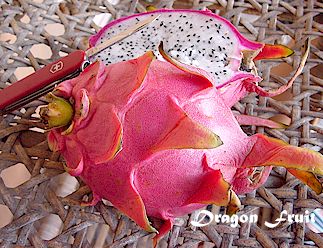 and, in the past,
also symbolized the emperor. One nickname for China is Dragon of the East
and Chinese people call themselves Long De Chuan Ren - Descendents of the
Dragons. There is even a song called Descendents of the Dragons which goes
something like this: ‘In the far far East, there is a dragon. Its name
is Zhong Guo (Middle Kingdom – the Chinese name for China). Those who
have drunk the water from the Long (Dragon) River will forever be the descendents
of the dragon.’
and, in the past,
also symbolized the emperor. One nickname for China is Dragon of the East
and Chinese people call themselves Long De Chuan Ren - Descendents of the
Dragons. There is even a song called Descendents of the Dragons which goes
something like this: ‘In the far far East, there is a dragon. Its name
is Zhong Guo (Middle Kingdom – the Chinese name for China). Those who
have drunk the water from the Long (Dragon) River will forever be the descendents
of the dragon.’
So, that’s why everywhere we go in China we see dragons! We’ll be including more dragon photos in upcoming travel logs.
A MEALTIME REFLECTION
Here’s a famous gushi poem that many Chinese school children recite before they eat:
Weeding
crops in the mid-day sun
Sweat drips to the earth under the crops
Who considers the food in his plate?
Every grain comes from hard work
Do you consider the food in your plate before you eat it – how far it has traveled and from where – and how much work it took to get it there?
Have a look at the same poem in pinying to see if you can figure out the original rhyme scheme:
Chu
he ri dang wu
Han di he xia tu
Shei zhi pan zhong can?
Li li jie xing ku.
The last words of the first, second and fourth lines rhyme, which, of course, gets lost in translation along with the original rhythm (count the syllables in each line).
GUSHI
Real gushi (ancient poems) are written with Chinese characters, of course. There are two main kinds: qi yan shi (seven character poems) and wu yan shi (five character poems). In Chinese, all characters are one syllable long. So, the poems have a specific rhythm thanks to the repeated number of syllables in each line. As you can see above, sometimes gushi rhyme and sometimes they don’t. The rhyming patterns vary from poem to poem. (I’ll tell you more about gushi next time.)
GUESS WHO
Here are two more guess-who animal poems written in gushi form, each with seven syllables per line. Notice that the end rhymes in the first poem follow the same rhyme scheme as the gushi poem above; while the second poem contains only internal rhymes (can you find them?). Guess who!
Animal #1
Skunks,penguins,
and tapirs too
In one way resemble you
But they don’t get hankerings
That make them binge on bamboo
Animal #2
Have
you heard that herd’s the word?
Source of life in treeless north
Forest of leafless branches
Hauls to call of Ho-ho-ho!
The answers to the poems in the last report are the camel, of course, and the komodo dragon.
Q & A EXCHANGE
Here are more answers to your questions. These questions were answered by (mostly fifth grade) students at the Jinha Elementary School in Jinha in the Xishuangbanna Rain Forest region of Yunnan Province.
1. What do you do for fun? We play running games and a game called ‘Hawk Catching Chicks.’ We also play soccer and basketball when we are free. We watch TV when we are at home and we like to read story books.
2. What are the popular sports in China? Basketball, soccer and ping-pong are very popular. We also run a lot and love to jump rope.
3. What kind of transportation
do you have? We ride bicycles around the town. When
we go to a bigger town, we have to cross the river first by ferry. Once we
get to a bigger town, we rid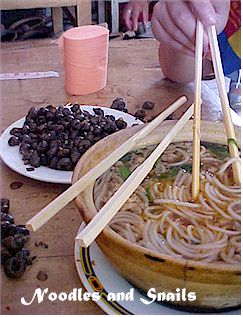 e
in cars and buses. Our parents own motorcycles. There's also a kind of three-wheeled
motorcycle that we use here as taxis and we call them ‘electric donkeys.’
Some of us have flown in airplanes when we go to Kunming, the capital city
of our Yunnan Province.
e
in cars and buses. Our parents own motorcycles. There's also a kind of three-wheeled
motorcycle that we use here as taxis and we call them ‘electric donkeys.’
Some of us have flown in airplanes when we go to Kunming, the capital city
of our Yunnan Province.
4. What do you see when you look out of the windows of your school? We see fields, our school garden and roads. We see trees and flowers. We see birds and butterflies.
5. How many students do you have in your class? There are more than 40 students in our class.
6. What subjects do you study in school? We take Chinese, Math, Natural Science, Ethics, Social Studies, Physical Education, Art and Music.
7. What are your favorite subjects? We love P.E., Art, Music and Math.
8. Describe your favorite place in China. One girl has been to a beautiful place in Yunnan Province called Shangri-la and she said it's her favorite place. Another girl said Lijiang, an ancient city in Yunnan, is her favorite place. Some students said an area around where they live called Tian Ba, is their favorite place because they love to sit there on the field and watch the sun setting behind the mountains. Some students love the fish farms because there are many birds and they can swim in the water. Some said they like the Mekong River because they can swim in it. One student said her grandma's house is her favorite place.
9. Describe the clothes
you wear for special occasions. Students of our school
are mainly of Hani ethnic minority group and a few of us are of the Dai minority.
Those of us who are Hanis wear traditional clothes for special occasions like
the New Year. The clothes are made of cotton and are mostly black, with colorful
embroidered fringes and white beads. Our clothes are usually a little heavy
and bulky so we only wear them for very special occasions. The Dai 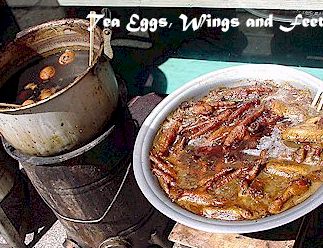 clothes,
on the other hand, are much lighter. They usually include a bright-colored
sarong skirt with the top of same color. The Dai clothes are comfortable to
wear all-year-round. But on special occasions, the women would put flowers
on their heads and carry paper umbrellas the same colors of their dresses.
clothes,
on the other hand, are much lighter. They usually include a bright-colored
sarong skirt with the top of same color. The Dai clothes are comfortable to
wear all-year-round. But on special occasions, the women would put flowers
on their heads and carry paper umbrellas the same colors of their dresses.
10. Does everyone use chopsticks to eat their meals? Mostly yes, although when we eat at school we mostly use spoons.
THAT’S ALL FOR NOW
That’s all for this travel log. In our next report, we’ll hop on a yak and climb up onto the Tibetan Plateau to visit towns called called Xiahe and Sangke. There, we’ll visit the famous Labrang Monastery and two Tibetan schools. Till then, learn lots! Zai jian!
Lilia and Paul
China Project Coordinators
================================================
E-Travel
Log #6: A Chinese Food Overview |
